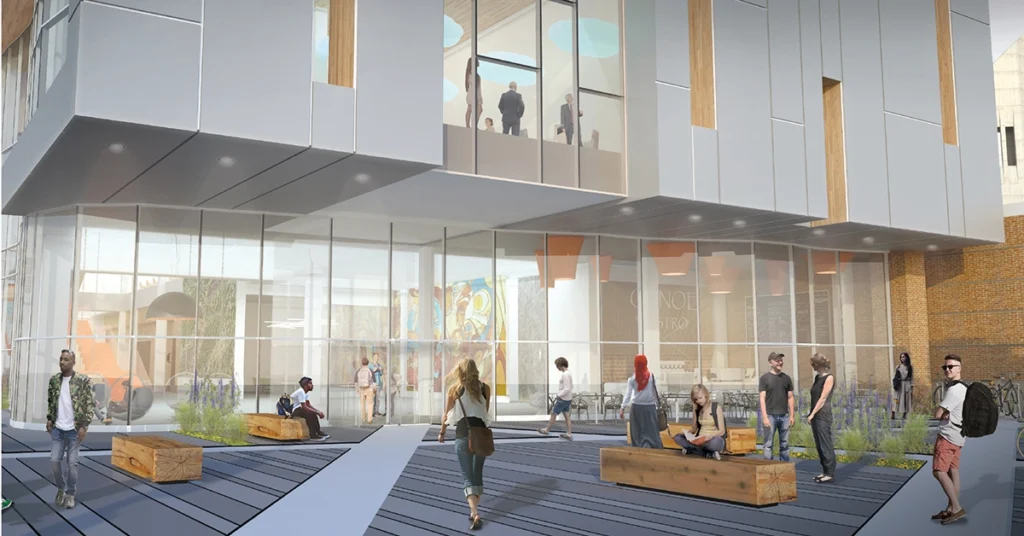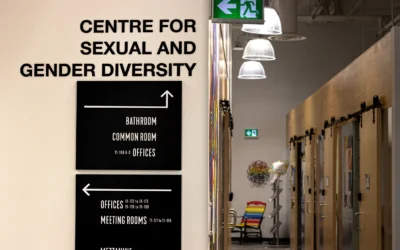Environmentally friendly, natural light, a moss wall, and a welcoming atmosphere. After 12 years of planning, the Students’ Association of MacEwan University (SAMU) broke ground on their new building last year.
Many of the final details are being decided and cleared, and many of the dreams of previous and current student executives are becoming a reality.
Although the building may not look like much yet, the foundational parts of the building are almost complete and the structural steel will be going up within the coming months, says Emma Patterson, the vice president of operations and finance at SAMU. As the frame of the building takes shape, some construction specifics are still in the works.
“We are just going through the final stages of ensuring that everything within the building is finalized — layout kind of things, how we want the aesthetics to be, what kind of ceiling are we going to have, really most of those final touches and making sure that the costs are within our budget,” says Stephanie Nedoshytko, SAMU’s president.
The budget for the building is $23 million, although that number was cut from an original $40 million plan. Despite certain aspects of the original grand vision being axed along with the budget cuts, there are a few things that are concrete and remain exciting, says Nedoshytko.
“It’s trying to find that balance, because we want to give the ultimate student experience and sometimes that comes at a cost,” says Patterson.
Because of the budget cuts, Patterson and Nedoshytko have to select the features that are important to have in the building versus what can be removed from the plan if need be.
One part of the new building that is certain, and was one of the main reasons the building was approved by students, is that it will be Aramark free. All the vendors will be run without Aramark involvement, and students will be permitted to cater their events however they choose — no need for approval or ordering through SAMU.

Other attributes include the building being Leadership in Energy and Environmental Design (LEED) silver certified. LEED certified buildings must comply with all federal, provincial, and municipal environmental laws and must place sustainability at the centre of all building plans
and operation.
The new SAMU building will have better air quality, use fewer toxic products, and have far more natural daylight than other buildings on campus. Through the reduction in waste, conservation of energy, and decrease in water consumption, LEED buildings are meant to drive sustainability innovation and boost productivity, according to the Canada Green Building Council.
“(There’s) natural light everywhere, the entire west side of the building is completely glass, and there’s a lot of cool features within it to really invite that natural light,” Nedoshytko says.
Student feedback led to the decision that the building is going to have a large space dedicated to clubs. Although available for all students to book, clubs will have priority when using the large boardrooms. The building is expanding a lot of SAMU areas to better suit student needs.
“We’re trying to really provide a space that is usable for clubs. We have a new expanded space for our breakfast club, we have a new expanded space for peer support, we have a new, more accessible space for Food Bank, and we will also have a Safe Walk desk for that building,” says Patterson.
There will also be all-gender bathrooms on every floor, and foot baths available for students. The students’ council room and events spaces have additional ventilation added so students who wish to smudge have a space pre-equipped for that purpose and don’t need to seek administrative approval, says Nedoshytko.
“Our ultimate goal within the design and how we’ve done it is, overall, we want to be the most accessible building on campus because we’re a student building. While students may find difficulty elsewhere on campus, they shouldn’t feel that way in the building that’s for them,” says Patterson.
“So a lot of our decisions have been making sure that accessibility in all regards is a big focus. Not just physical, but also visual, auditory. We brought in a special consultant to help us ensure accessibility throughout the whole building.”
What hasn’t been finalized yet, however, is what businesses will be added to the space. Although the building could have all kinds of retail options, student feedback indicates that every available space will likely be allocated to food options.
“We’d also love to hear anything that students are really hoping for in terms of food options or retail within the building … So far our top options for food are pizza, donairs are number one, the sit-down café concept … with the potential for alcohol and fresh-squeezed juice,” says Nedoshytko.
Once the building is up and ready, SAMU will vacate all of its current spaces on campus. The two SAM Centre locations and all offices will be moved to new locations in the building. The only area that will remain is Safe Walk, which will still be allowed to use the welcome desk in the evenings. It is uncertain if large, outdoor events like Fall Fest will remain in front of Building 7 or if the SAMU building plaza will be big enough to hold them.
The building is on track to be finished on time, and the opening date of fall semester 2019 is something that SAMU has a hard deadline on. Even if operationally the building needs to be worked on, the opening day can be relied on.
“There’s a lot of challenges we’ve had to go through with this project, and I think when you’re relying on so many different people and so many different contractors to do all of their specific trades, and even waiting on the architect for certain design aspects to come through … but we’ve been hard on the final deadline, and if it doesn’t happen, I’ll be out there myself with a hammer,” Nedoshytko says.
Students are encouraged to use the building website, samubuilding, or send in emails to the VP of operations and finance if they have questions, suggestions, or concerns.
Graphics supplied.





0 Comments